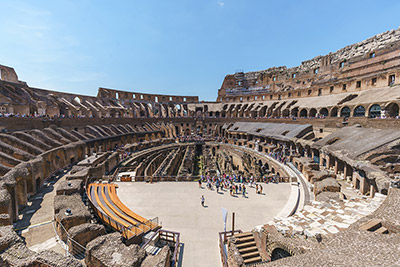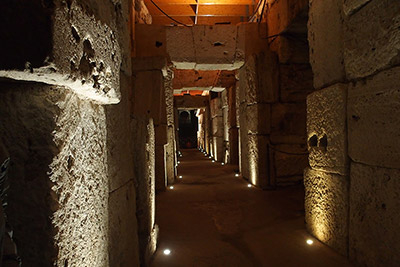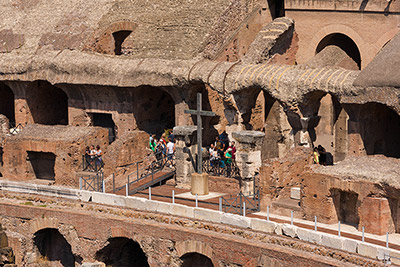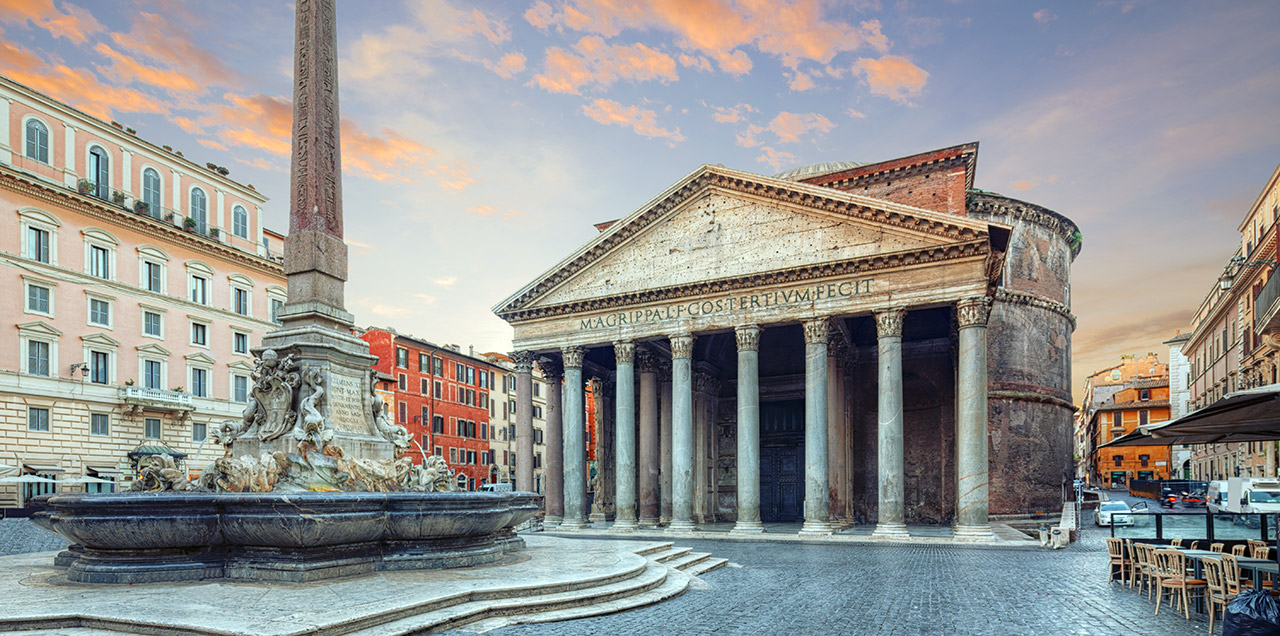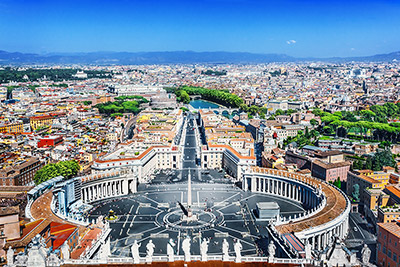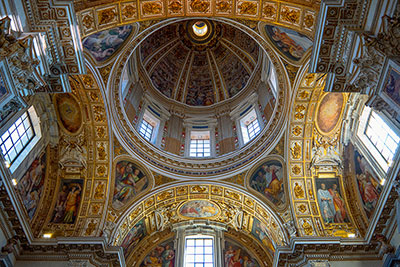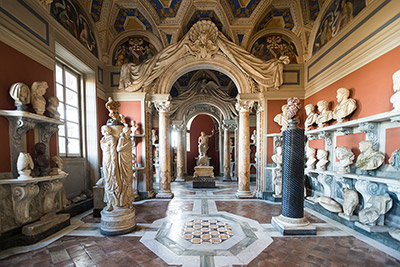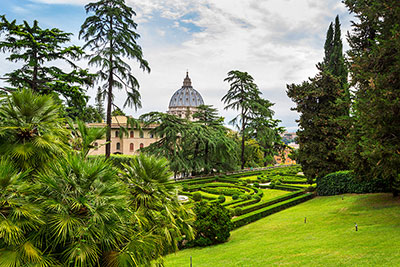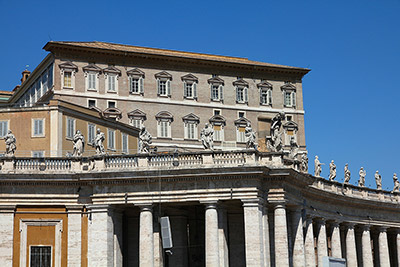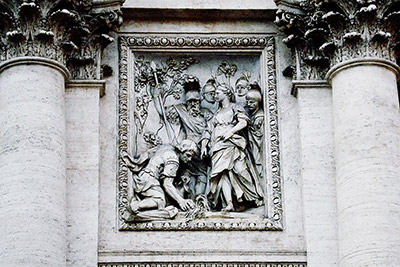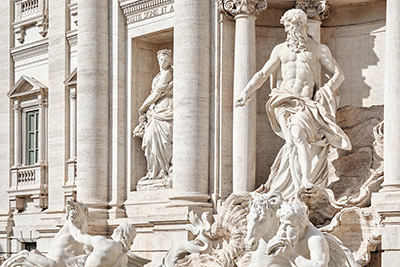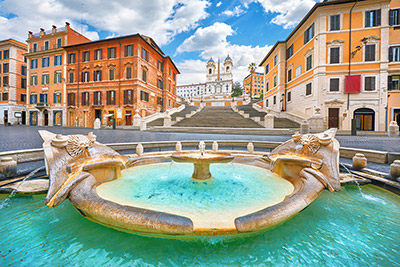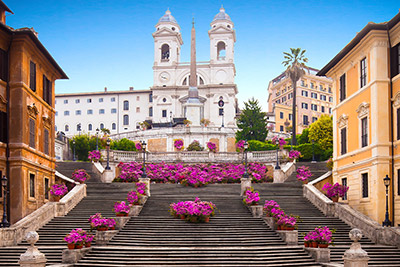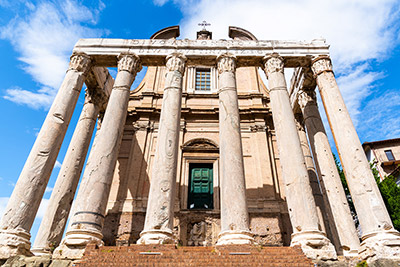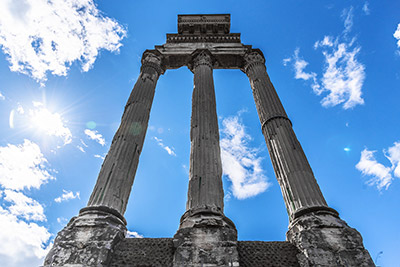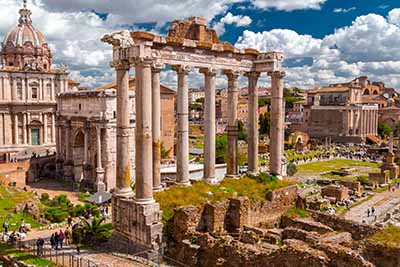Things To See and Do in Rome
The Colosseum

The Colosseum is an impressive, imposing, ancient amphitheatre that has looked down over the city since 80AD, representing the awesome might of the Roman Empire. Over the centuries this iconic landmark has become almost synonymous with visiting Rome - it's a place you certainly cannot miss!
Colosseum in Pictures
Explore the iconic Colosseum through these stunning images.

The Colosseum

Arch of Constantine - Near Colosseum

Colosseum Arena Floor

Colosseum Underground Tunnels

Emperor's Seat with Crucifix
Visting The Colosseum
1. The Outer Wall
In its heyday, the outer walls of the Colosseum once stood at 57 meters tall, 186 meters long, and 156 meters wide, in a grand oval shape. The walls were built using large blocks of travertine marble, held together by iron clamps. After many centuries and natural disasters, the entire south side of the outer wall collapsed in 1349.
2. The Arena Floor
Take a walk across what once was a blood soaked arena floor to catch a glimpse of history, gazing up into the stands. As you enter the arena floor as gladiators did 2000 years ago, you get an incredible view of this massive structure. It is worth noting that this area is strictly limited to those who are on a guided tour of the Colosseum.
Guided tours that include the arena floor can cost anywhere from $30 to $65 and are only available through advanced booking.
3. Underground
The Colosseum is no less of an iconic landmark below ground as it is above! It is in these underground tunnels that gladiators and wild animals were kept before being brought into the arena to meet their fate - almost comparable to a backstage area.
4. The Emperor's Seat
Within the seating arrangement of the Colosseum, the Emperor obviously had the advantage of the best seat in the house. This private box was on the ground level, right in the middle, so he could get up close and personal with the action. You can see where the seat once stood by looking for the crucifix.
The Roman Colosseum in Video
Vatican City

Within Rome is the world's smallest sovereign state - Vatican City - governed by the Holy See, which makes it an ecclesiastical state that is ruled by the Pope and the Catholic church. However, you don't have to be a Catholic to appreciate this extraordinary City state.
Vatican City is bustling with tourists all year round, and almost constantly throughout the day, so it can be best to visit early in the morning to make sure you have enough time to see everything after standing in long queues. The area is also generally busiest on Wednesdays and Sundays when the Pope typically gives a midday blessing.
Vatican City in Pictures
Discover the beauty of Vatican City through these images.

St. Peter's Basilica & St. Peter's Square

St. Peter's Basilica, Vatican

St. Peter's Square, Vatican

Dome of Sistine Chapel, Vatican

Vatican Museum Stairs

Inside Vatican Museums

Stairs & Hallway Inside Vatican Museums

Rotonda Hall, Vatican Museums

Papal Apartments, Vatican

Vatican Gardens with St. Peter's in Background

Garden in Vatican Gardens
Things to See & Do in Vatican City
1. St. Peter's Basilica
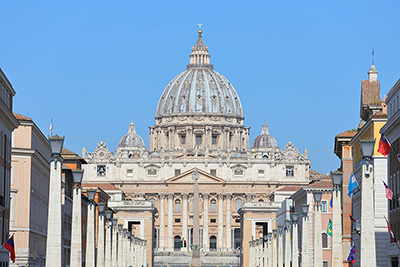
Regardless of your religious affiliation, no trip to Rome would be complete without a visit to the majestic St Peter's in the Vatican. Its vast dome can be seen from several spots in the city; up close, you get a full and almost overwhelming sense of its scale, as well as the experience of seeing Catholic pilgrims from all over the world as they make their way through the square that lies in front and amongst the colonnades that surround it. Entering - which is well worth it, for an interior look at the dome, as well as for the incredible array of sculpture and artwork housed inside - is free (although you may wish to pay in order to skip the security line). If you're of a reasonable standard of fitness, climbing the 231 stairs to the top of the Dome is well worth the effort - otherwise, there is also an elevator. Not only will you get to see the mosaics that make up the dome's design up close, but you can also venture out onto the roof and stand with the Twelve Apostles as you feast your eyes on epic views of the Eternal City.
Other notable things to check out are the Tomb of St Peter (located below the High Altar), the Baldacchino (look up it's the canopy suspended over the High Altar), and the Loggia Delle Benedizioni (the balcony used to give the annual Christmas and Easter addresses, as well as announce the new Pope when required.
2. St. Peter's Square
At the foot of St. Peter's Basilica is one of the biggest squares in the world, boasting a length of 320 meters and a width of 240 meters. During popular events, this enormous square can hold more than 300,000 people. In addition to its impressive size, St. Peter's square also houses 284 columns and 84 pilasters that tower over the square. In the center, gaze skyward towards the 25 meter tall obelisk, before casting your eyes down to the two 17th century fountains.
3. The Sistine Chapel
It goes without saying that no visit to the Vatican Museums is complete without looking around the Sistine Chapel. The most famous part of this building is the 9 scenes from Genesis painted onto the ceiling by Michelangelo Buonarotti. Also look for Michelangelo's The Last Judgement, and the frescos by master renaissance painters such as Botticelli, Perugino, Pinturicchio, and Ghirlandaio.
4. Vatican Museums
The Vatican Museums are one of the largest in the world, boasting over 7 kilometers of art galleries. As you can imagine, there is so much to see that it can be impossible to see it all. So, if you only have a limited time, or it is your first time visiting, here are some of the highlights you simply cannot miss.
The Sala Rotonda and Porphyry Basin - Modelled after the Pantheon, the Sala Rotonda (or, Rotunda Room) is majestic from the top of the roof to the floor under your feet. Arguably the most must-see feature in this room is the porphyry basin, a 40-foot bath carved from a single piece of igneous rock for Emperor Nero's Golden House.
5. Vatican Gardens
If you are looking for a bit of peace and quiet within this popular tourist city, then look no further than the Vatican Gardens, or the Giardini Vaticani. It has a limited entry system to ensure that it is rarely ever crowded. Not only this, but it boasts fantastic views of the Basilica, and across Vatican City. Either leisurely stroll around the 57 acres of sculptures, botanicals, and fountains, or opt for a guided tour and audio guide.
6. The Papal Apartments
The Papal Apartments is a collection of residences where the popes used to live in what is now the Vatican Museums. The most impressive (and unmissable) of these are the Raphael rooms and the Borgia apartments.
Trevi Fountain

The 'fountain of three roads', the Trevi Fountain was originally commissioned in the 17th century, before finally being built over a hundred years later by Nicola Salvi, and finished by Giuseppe Pannini after Salvi's passing. Though most people might head to the Trevi Fountain to just snap a photo, throw in a coin, and leave, there is much more to see while you are there.
Trevi Fountain in Pictures
Check out some great shots of the Trevi Fountain

Trevi Fountain

Trevi Fountain Reliefs

Trevi Fountain Statues

Trevi Fountain with Night Lighting

Crowds Around Trevi Fountain
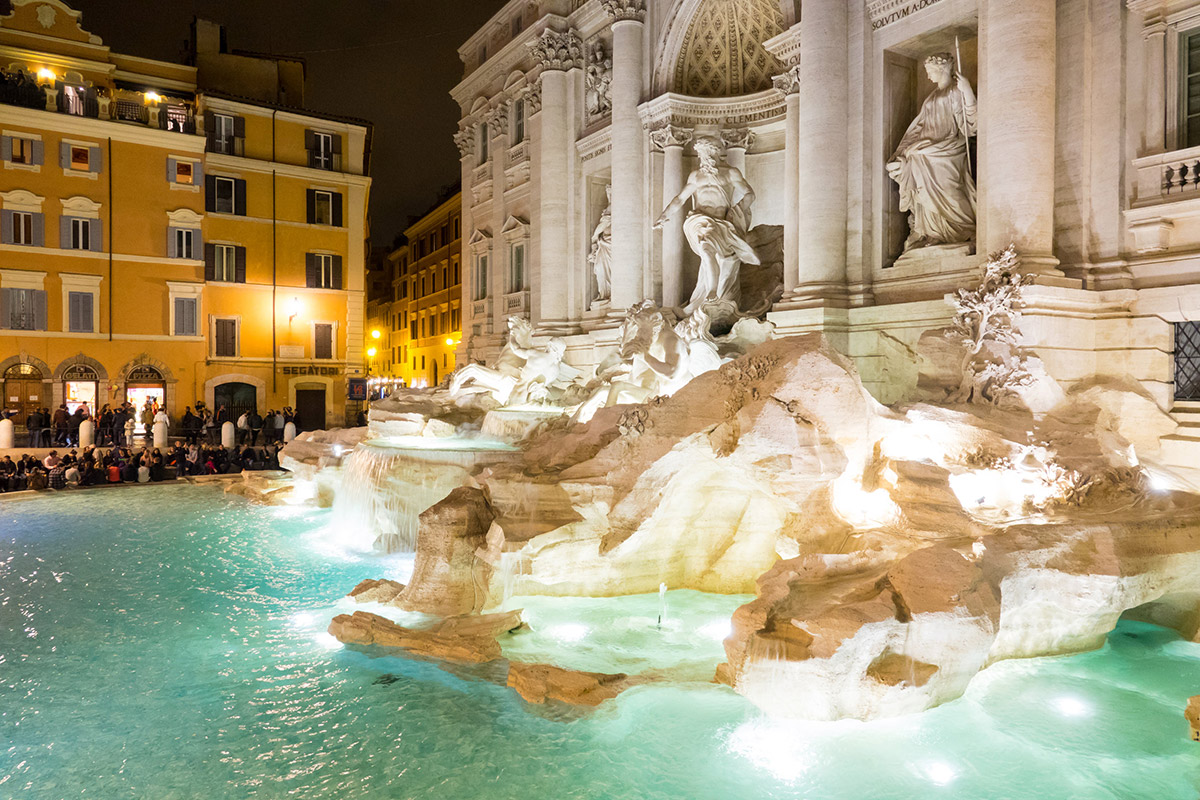
Trevi Fountain with Night Lighting

Trevi Fountain Statues

Oceanus Statue - Trevi Fountain

1 of 2 Tritons with Winged Horse - Trevi Fountain

2 of 2 Tritons with Winged Horse - Trevi Fountain
Things to See at Trevi Fountain
1. Statue of Oceanus
The statue of Oceanus is the central focal point of the entire fountain. As the Titan god of the sea, it seems only fitting that he rides a shell pulled by two Tritons, one of which represents the sea's roughness, and the other its tranquillity.
2. Reliefs
Above the centerpiece of Oceanus, you will find a couple of relief sculptures - namely, the Relief of Young Girl and Troops, and the Relief of M.Agrippa Building Aqua Virgo. These reliefs illustrate the importance of fresh water, and celebrate the building of the aqueduct that supplied all of Rome.
3. Symbolic statues
You can also find a variety of symbolic statues on the Trevi Fountain, that represent the Abundance of Fruits, Fertility of Crops, Products of Autumn, and Joy of Prairie and Gardens. These statues are used as status symbols for the Romans, highlighting just how important water is, and how much the Romans had as a luxury.
The Trevi Fountain in Video
The Spanish Steps

Did you know that the Spanish Steps are only known as the Spanish Steps in the English language? This was probably coined by John Keats or Shelley who lived nearby, facing the steps and the encompassing Piazza di Spagna. In fact, their original Italian name is La Scalinata di Trinità Dei Monti, or The Steps of the Holy Trinity of the Hill. However, there is much more to the Spanish Steps than the steps themselves. Here are some things you definitely should check out.
The Spanish Steps in Pictures
Check out some great shots of the Spanish Steps and Surrounding Area

The Spanish Steps
Things to See & Do at the Spanish Steps
1. La Fontana Della Barcaccia
At the bottom of the steps is La Fontana Della Barcaccia, a baroque fountain of a boat, inspired by an immense flood in 1598 that caused a boat to flow from the Tiber river into the Piazza di Spagna. The water that flows through the fountain comes from the Acqua Vergine aqueduct, which is good enough to drink. Just make sure you take a sip straight from the spouts and not from the pools at the bottom.
2. Church of the Santissima Trinità Dei Monti
At the top of the steps is the French church of the Santissima Trinità Dei Monti. Originally incompletely constructed by Louis XII after invading Naples, the church was completed by Pope Sixtus V in 1585.
The Spanish Steps in Video
The Roman Forum

Although the remains of the Roman Forum only give a hint to the wealth and magnificence of the area in its prime, it still stands as a very popular tourist hotspot. To get the most of the trip, it is recommended to explore the area with a guide. Here are some of the temples you should look out for.
The Roman Forum in Pictures
Check out some great shots of the Roman Forum and Surrounding Area

Temple of Saturn - Roman Forum

Temple of Saturn - Roman Forum
Things to See & Do at the Roman Forum
1. Temple of Antonius Pius
Built in 141 AD, this temple was constructed to honor the life of Antonius Pius and his wife after death. To this day, six columns and Corinthian capitals survive at the front, as well as a few columns along the side. The temple was converted into the church of San Lorenzo in Miranda in the 12th century.
2. Temple of Castor and Pollux
Though only three Corinthian columns survive of this temple, at 12 meters tall they are nothing but impressive. These three columns are known as the Three Sisters.
3. Temple of Saturn
The Temple of Saturn was one of the most important temples in the area, built in around 497 BC. Despite being destroyed in several fires over the years, it has been repeatedly rebuilt, the last in the fourth century AD.


